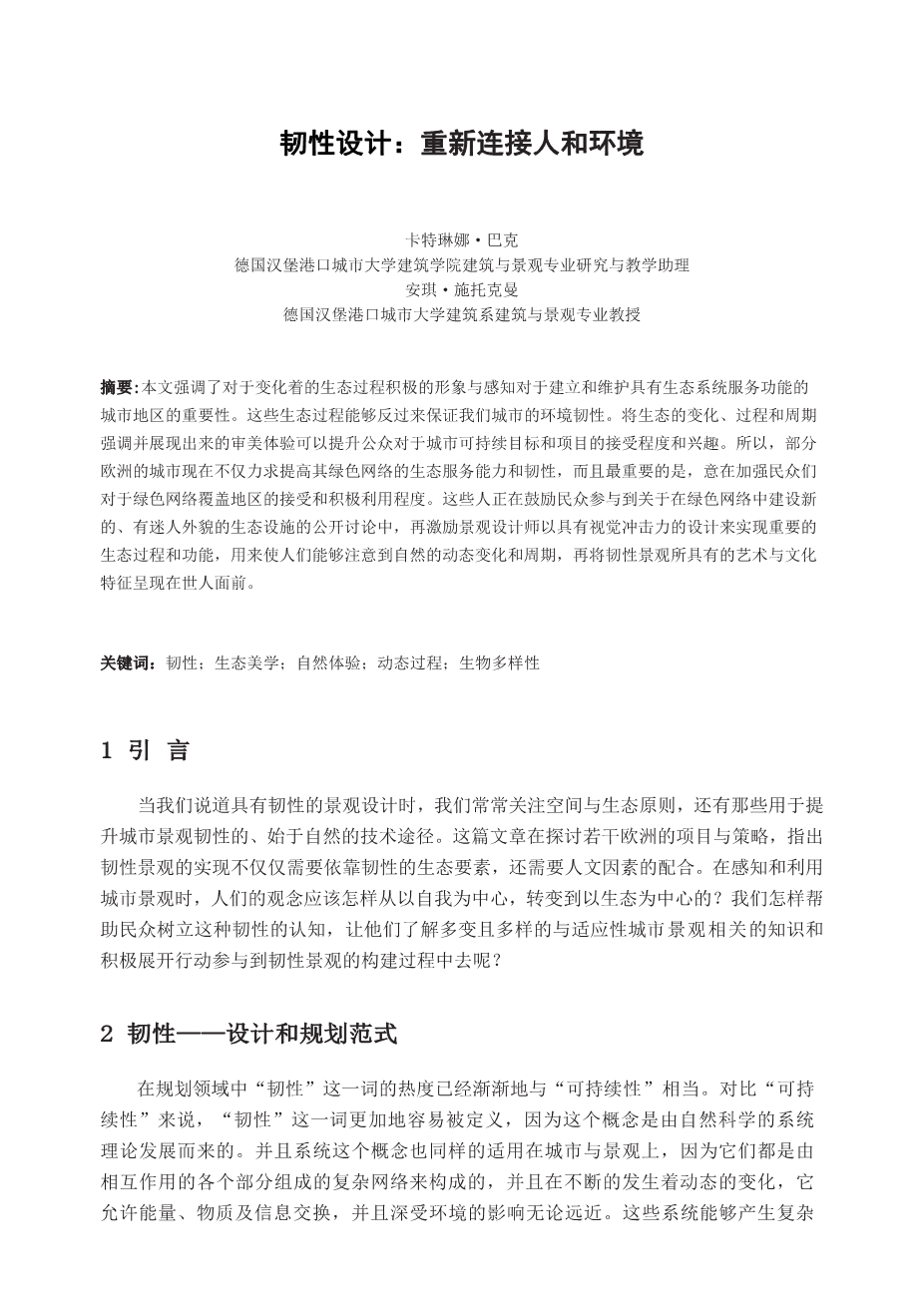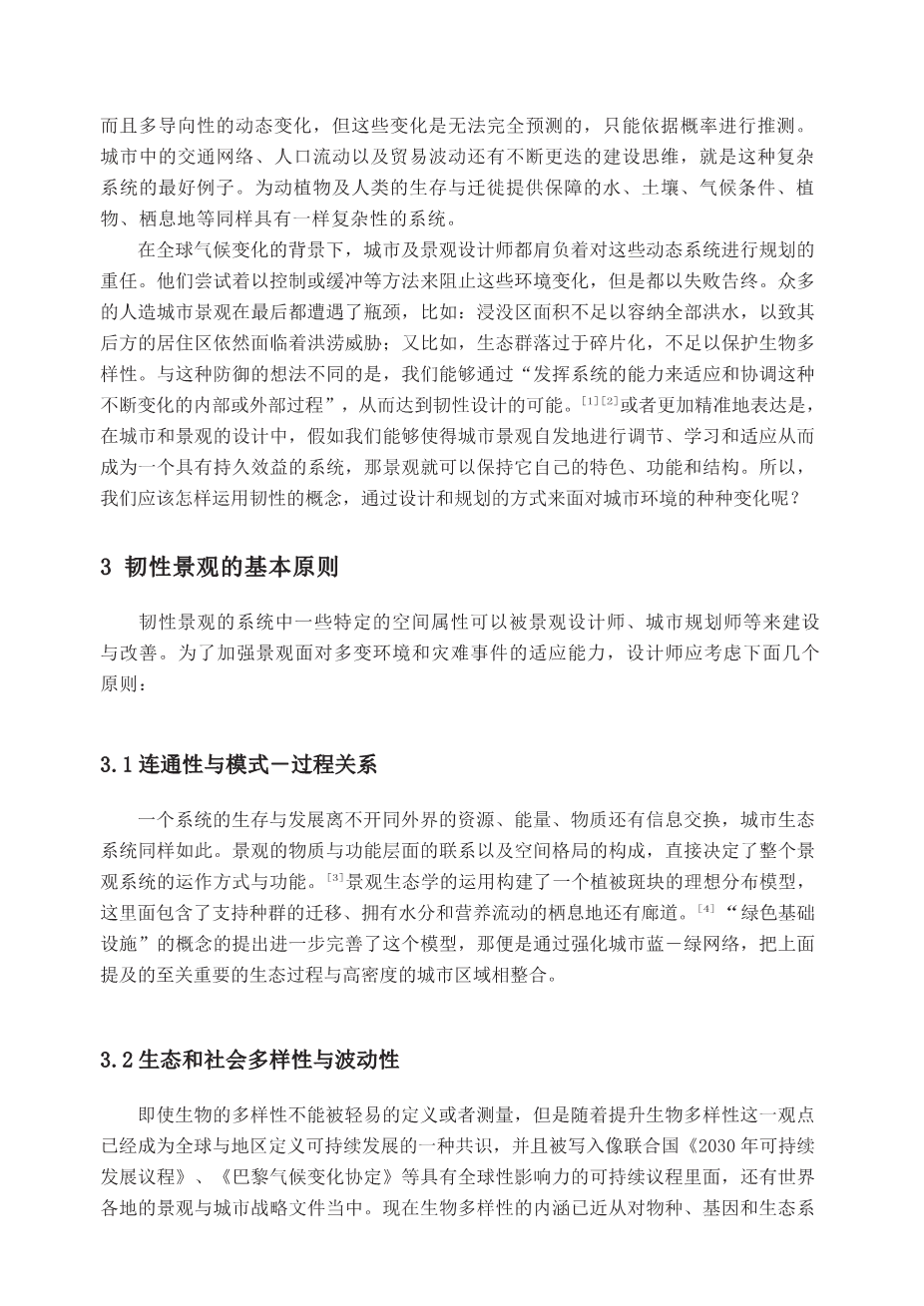韧性设计:重新连接人和环境外文翻译资料
2022-08-06 09:56:35
DESIGN FOR RESILIENCE:
RE-CONNECTING COMMUNITIES AND ENVIRONMENTS
Katarina BAJC
Research and Teaching Associate of Architecture and Landscape, Department of Architecture, HafenCity University Hamburg
Antje STOKMAN
Professor of Architecture and Landscape at Department of Architecture, HafenCity University Hamburg
Uuml;berseeallee 16 20457 Hamburg, Germany antje.stokman@hcu-hamburg.de
ABSTRACT
This article stresses the importance of positive image and perception of dynamic ecological processes for the implementation and care of areas which provide ecosystem services within the city. Those in turn secure the resilience of our urban environment. Aesthetic experience with emphasis on highlighting and revealing the presence of ecological dynamics, processes and cycles can increase the acceptance and interest for sustainable goals and projects within the city. Thus, several European cities are currently implementing strategies not only to enhance the capacity of their green networks for ecological services and resilience but most importantly to enhance the acceptance and active use of such areas. They are integrating the public in an
open debate about implementing new attractive ecological amenities within a green network, and also stimulating landscape architects
to find ways to design important ecological processes and functions in an eye-catching and spectacular way. The natural dynamics and cycles are thus brought to the attention of the people and present an important artistic and cultural component of resilience.
KEY WORDS
Resilience; Ecological Aesthetics; Nature Experience; Dynamic Process; Biodiversity
Introduction
When we talk about resilient landscape design, we generally focus on spatial and ecological principles and technical nature-based solutions to support the resilience of urban landscapes. This article argues that it will take more than ecological parameters for designed landscapes to become resilient, and examines the role of people
and the cultural component of the resilience agenda by discussing current projects and strategies in the European context. How can we change the human perception and use of urban landscapes from an egocentric to a more bio-centric perspective? How can we support
a resilient citizenship, based on an imperative of acknowledgment, engagement, and activism in and for adaptive, dynamic and diverse urban landscapes?
Resilience as a Design and Planning Paradigm
“Resilience” is a new buzzword in planning disciplines slowly gaining popularity against the concept of sustainability. In
comparison to sustainability, it is easier to define because it derives from systems theory based on natural sciences. The concept of a system also applies to cities and landscapes. They are composed of networks of interacting components in a constant state of becoming, open to the flows of energy, material, and information, and affected by adjacent as well as distant circumstances. Dynamic changes that occur as a result are complex and multidirectional, impossible to fully predict and can only be understood based on probabilistic assumptions. Cities with their traffic veins, migrations, trade fluctuations, and ever-changing construction speculations are prime examples of such erratic states. So are the waters, soils, climates, vegetation and habitats that support life and migration of flora and fauna as well as humans.
Urban and landscape planners are left with a task to plan and design this fluid state, in the wake of global climate change. Their attempts to prevent changes in the environment, to control them, to compensate them have been failing greatly. Many man-made urban landscapes eventually reach a threshold where the space for flood is not large enough to prevent the flooding of inhabited areas or where the biotopes become too fragmented to prevent the loss of biodiversity. The resilience approach as an alternative to resistance approach can be achieved if
we manage to support the “ability of a system to adapt and adjust to changing internal or external processes.”[1][2] Or more precisely, if we manage to integrate the persistence of systems by self-organization, learning, and adaptation into urban and landscape design, in such a way that landscapes retain their identity, function, and structure. How can the resilience concept be applied as a response to change and as a form of action in the planning and design of urban environments?
General Principles of Resilient Landscapes
Resilient landscape systems display certain spatial attributes which can be constructed and influenced by landscape architects, urban designers, and other planners. To support the landscapersquo;s ability to adapt to changing environmental influences and disruptive events, designers can consider the following principles:
Connectivity and Pattern-Process Relationship
The survival and thriving of a system is dependent on the flow of resources, energy, material, and information through it. This is as well true of urban and ecological systems. Physical and functional connectivity and the spatial configuration of patterns in landscape directly determine its processes and functions.[3] The applied science of Landscape Ecology has developed models for optimal dispersion of vegetation patches with different habitats
and corridors for species movement, and nutrient and water flows across the landscape.[4] The concept of green infrastructure is taking it further in an attempt to integrate these vital ecological processes in dense urban areas, by strengthening the green and blue networks within the city.
Ecological and Social Diversity and Variability
While it is not easy to defi
剩余内容已隐藏,支付完成后下载完整资料


英语译文共 5 页,剩余内容已隐藏,支付完成后下载完整资料
资料编号:[254989],资料为PDF文档或Word文档,PDF文档可免费转换为Word




